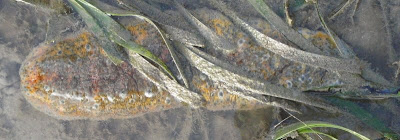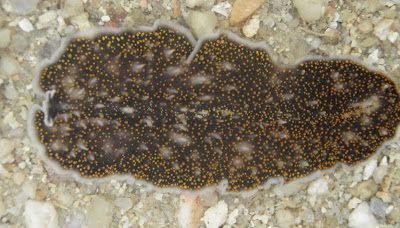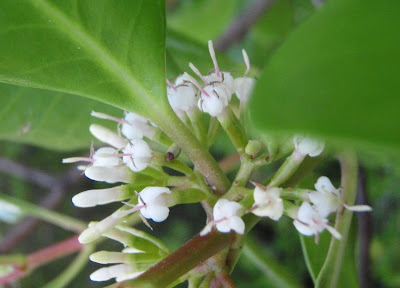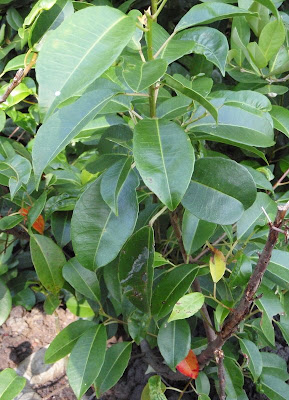Fifty Seventh Discovery posting
Update on 12 May 2008: Upon some feedback, I've modified or added some facts. Discoverers will find a * to a modified or added fact. Thanks to Ria for the info =)
My first time guiding at Changi beach. We had a group of girls from MGS and we were group 'Stingray'. Although we didn't saw ourselves, we did saw lots of other interesting marine creatures.
Here's the sunrise which amazed all Stingrays (picture below), too bad i didn't push the group photo idea further. =P

In this posting, I would focus on a group of creatures called echinoderms. This is because that we saw lots of echinoderms and I was saying the term a lot of times during guiding, so to give a better outlook to all stingrays what echinoderms are, here we go...
Small Warning: This post is a bit info packed, so do be mentally prepared. =)
Discovery Note (Some characteristics of echinoderms):
1. The echinoderms are a group of animals that includes sea stars, sand dollars, urchins, feather stars, brittle stars and sea cucumbers.
*2. They are animals which lack a brain and but possess complex sensing organs.
3. They have a water-vascular system (humans have a blood-vascular system) which pumps water through the madreporite.
4. The madreporite is an opening used to filter water into the water vascular system of echinoderms.
5. And they have tube feet which they use to attach to objects, for protection, as well as to obtain food.
*6. They have 5-sided or pentamerous radial symmetry, this is visible in most sea stars and most can regenerate lost limbs.
*7. Successful regeneration also requires that certain body parts be present in the lost pieces. For example, many sea stars can regenerate a lost portion only if some part of the central disk is present.
*8. The body wall of an echinoderm has a clcium crabonate internal skeleton of dermal ossicles that take many forms. For example, the sea urchin has plate-like ossicles which are fused to form a shell-like test while ossicles in sea cucumbers are reduced to microscopic size.
*9. Another interesting fact about echinoderms is that you can find the presence of a tissue called the "catch connective tissue" which is unknown to exist elsewhere in the animal kingdom. This tissue acts like a kind of molecular Velcro and gives the body wall considerably rigidity. This is the reason why a sea cucumber can feel quite stiff one minute and soft the other.
So our
first and second 'discoveries' are sea urchins (picture below).

 Discovery Note:1.
Discovery Note:1. Sea urchins belong to the class Echinoidea.
2. Depending on the species, movable spines of various sizes and forms are attached to the body. These spines often are sharp, pointed and in some species even poisonous. The sea urchins use also their spikes to move around.
3. And between their spines are small, pincer-like organs called the pedicelliariae which they use to clean and defend themselves. The pedicelliariae also contains a powerful toxin.
Discovery Note (Ecology and range of echinoderms):1. Echinoderms are exclusively marine.
2. They can be found in various habitats from the inter-tidal zone down to the bottom of the deep sea trenches and from sand to rubble to coral reefs and in cold and tropical seas.
Discovery Note (Diet of echinoderms):1. Some echinoderms are carnivorous (for example starfish) others are detritus foragers (for example some sea cucumbers) or planktonic feeders (for example basket stars).
2. Echinoderms are protected through their spiny skins and spines. But they are still preyed upon by shells (like the triton shell), some fish (like the trigger fish), crabs and shrimps and by other echinoderms like starfish which are carnivorous. Many echinoderms only show themselves at night (nocturnal), therefore reducing the threat from the day time predators.
Another type of echinoderms is the sea cucumber, here are two of them (picture below),
third and fourth 'discovery'.
 Discovery Note:1.
Discovery Note:1. Sea cucumbers belong to the class of
Holothuroidea.
2. These echinoderms are generally long and worm-like.
*3. Some sea cucumbers have loaded their body wall with toxic substances to deterrent their predators.
*4. Some sea cucumbers possess sticky threads or tubules, known as Cuvierian tubules, that are ejected through the anus to repel and possibly entangle potential predators.
Discovery Note (Reproduction of echinoderms):1. Most species of echinoderms are diecious, meaning there are separate male and female individuals.
2. Sexual reproduction involves the external fertilization of eggs by spermatozoa. The fertilized eggs develop into planktonic larvae.
3. The larvae typically go through two stages, called bipinnaria and brachiolaria. They are bilaterally symmetrical and have bands of cilia used in swimming and feeding. As the larvae gradually metamorphose into adults, a complex reorganization and degeneration of internal organs occurs. The left side of the larva becomes the oral surface of the adult, which faces down, and the right side becomes the aboral surface, which faces up. The larvae settle to the sea floor and adopt their distinctive adult radial symmetry.
We also spotted sea stars, a very well-known echinoderm, but before we talk about them further, let us take a look at the brittle star (the small thing below the sea star in the picture below),
fifth 'discovery'.
 Discovery Note:
Discovery Note:
1. Brittle Stars belong to the class
Ophiuroidea.
2. Related to and like the sea stars, they have five arms and a central disc.
3. As the name suggests, the arms of the brittle stars are rather liable to break. This is actually an escape mechanism. They can regenerate their arms, but slowly.
4. Brittle stars use their arms for locomotion. They do not, like sea stars, depend on tube feet.
5. Brittle stars move fairly rapidly by wriggling their arms which are highly flexible and enable the animals to make either snake-like or rowing movements.
Lastly, let's turn our attention to sea stars (picture below)


A knobbly sea star (picture below)

A knobbly sea star? A hybrid? Or a totally new species? (picture below)
 Discovery Note:1.
Discovery Note:1. Sea stars belong to the class of
Asteroidea.
2. Sea stars typically possess five arms that grade into the central disc. There are species which have six or even eight arms!
3. The mouth is located in the center of the underside of the disc and the entire undersurface of the disc and arms is called the oral surface.
4. The opposite, or upper side of the body, is the aboral surface that bears the anus and the ‘madreporite’, which is a small perforated plate through which water is taken into the water vascular system. Another learning point for me!
5. The water is then directed into canals in the arms and then into the tube feet, which extend with the water pressure.
6. The tube feet are very important to sea stars; they are used for locomotion, food collection and respiration. Sea stars move by adhering their tube feet to the substrate and pulling themselves along. They also use their tube feet to catch their prey.
7. Some sea stars are predators that prey on worms, crustaceans and bivalves while some are known to eat decayed plant matters.
8. Many sea stars eat with their stomach outside their body.
When doing this, their tube feet will pull the two shells of a bivalve apart. And while still attached to their prey’s body, they extend their stomach out through their mouths into the bivalve shell.
9. They will then release digestive juices which will liquidate the victim and cilia transport the bivalve into the sea star’s body.
It was a great trip as all stingrays were all enthusiastic about everything they saw and attentive when needed =P. Thank you, stingrays, and do note the learning points for me cause they are the mistakes I've made. =)
Reference websites:1. http://www.oceaninn.com/guides/echino.htm2. http://www.starfish.ch/reef/echinoderms.html3. http://tolweb.org/Echinodermata4. http://animaldiversity.ummz.umich.edu/site/accounts/information/Echinodermata.html5. David J. W. Lane & Dider Vandenspiegel. A Guide to Sea Stars and other Echinoderms. Singapore Science Center, 2003.
Extra:a) Read
manta's experience to see what his group saw.
 The underside side(picture below).
The underside side(picture below). Discovery Note:
Discovery Note: Discovery Note:
Discovery Note: And here's a whole group shot of all the students from Tampines Secondary School who came for the walk today. =)
And here's a whole group shot of all the students from Tampines Secondary School who came for the walk today. =) Thanks to all Giant Clams for being such a wonderful and attentive audience. It was a great day out with you guys! =)
Thanks to all Giant Clams for being such a wonderful and attentive audience. It was a great day out with you guys! =)




















































